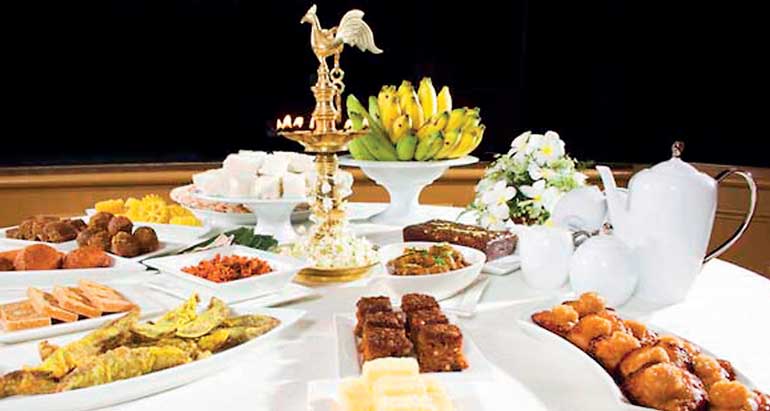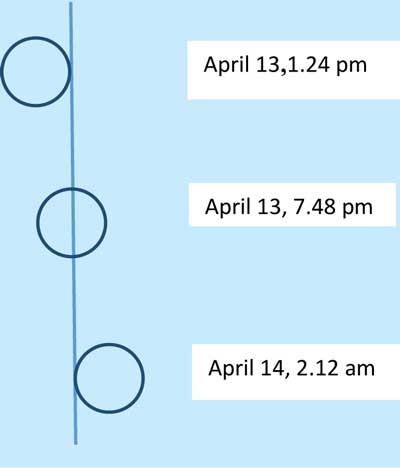Thursday Apr 24, 2025
Thursday Apr 24, 2025
Wednesday, 13 April 2016 00:00 - - {{hitsCtrl.values.hits}}

This is one day when we can bridge many divides in our society and almost all of us eat the same thing at the same time
Today at 7:48 p.m., the sun crosses an imaginary line that separates the constellation Pisces from Aries, marking the dawn of the Sinhala and Tamil New Year. The time for lighting the hearth and cooking the first meal in the New Year is set at 8:06 p.m. and the first meal at 8:54. The prescribed meal is kiribath (with lunumiris of course) and mungkavun, a sweet made of mung bean.
You don’t have to believe in astrology to participate in these festivities. There is some interesting astronomy which can be a good excuse to make the day and the times feel special. The starch heavy diet makes you feel sleepy and appreciate that you do not eat in this style the rest of the time. More importantly this is one day when we can bridge many divides in our society and almost all of us eatthe same thing at the same time.
Astrology and astronomy
 Viewed from the earth, the sun’s disc takes 12 hours and 48 minutes to cross an imaginary line in the sky. Astrological New Year marks the crossing of the imaginary line. It separates the astrological positions of the constellations Pisces and Aries (the actual positions have changed over time). For 2016, the sun begins this transition on 13 April at 1:24 p.m. and completes the transition at 2:12 a.m. on 14 April. This transition period is called the PunyaKalaya.
Viewed from the earth, the sun’s disc takes 12 hours and 48 minutes to cross an imaginary line in the sky. Astrological New Year marks the crossing of the imaginary line. It separates the astrological positions of the constellations Pisces and Aries (the actual positions have changed over time). For 2016, the sun begins this transition on 13 April at 1:24 p.m. and completes the transition at 2:12 a.m. on 14 April. This transition period is called the PunyaKalaya.
The first half of the transition period is the do-nothing or the Nonagatha period. When we were children, the hearth was cleaned of all the ashes and the last bucket of water was drawn from the well to prepare for the Nonagatha. No work, not even reading and writing, was allowed except for a trip to the temple.We waited in anticipation for the end of the Nonagatha and the beginning of the second half when up in the sky, the sun’s discwould becentred on the imaginary line. As soon as that time arrives, as told to us by astrologers, fire crackers start to signify the dawn of the New Year. For 2016, the dawn of the New Year is at 7:48, exactly six hours and 24 minutes after the beginning of the transition.
The second half is the active period. Astrologers pick the timesto draw the water from the well, light the fire, cook the food and eat the food,using some obscure calculations. It would be better if we arithmetically divide the time for each task, but then astrologers would be jobless. For 2016, the prescribed time to start cooking is 8:05. The time to eat is set at 8:54.They also suggest you eat kiribath and mungkavunfor the occasion. You don’t have to buy intothephony calculations to enjoy one time of the year when we all overindulge on the same food at the same time.
 What we ate then and now
What we ate then and now
Traditional meals are in some ways frozen in time. The Avurudu meal is exceptionally heavy on starch. Additional bit of protein comes fromthe Maldive fish in the lunumiris. Did Sri Lankanseat a lot more starch than accompaniments in the old days?
According to the 1980 Household Income Expenditure Survey of Sri Lanka, the amount of rice a household consumed went down from 46.7 kilos per month to 34.8 kilos per household. Rice is still the centre piece in our rice and curry diet, because the household size went down from 4.9 to 3.9. However, people are now eating more meat, fish and milk products. Households increased their consumption of meat from 0.8 kilos per month to 1.6 kilos, but increased the consumption of fish only marginally from 3.5 kilos per month per family to 3.7. Consumption of dried fish went down from 1.4 to 1.2, I am sad to notice.
The data is not broken down by income group, but the well-to-do would be eating much less rice and more accompaniments.
Eat together and stay together?
They are many adages about eating together. The family that eats together stays together is my favourite. Another one we might add is that a country that eats together stays together. Here I don’t mean the familiar ethnic divide. I am thinking more of the Westernised/non-Westernised divide.
There was a time when the Sinhala elite thought it beneath them to eat rice ad curry. Once I was shocked to hear that in the 1930s before independence, an elite Sinhala family from the south would have rice and curry only on Sundays. The rest of the days they ate courses, whatever that meant. There seems to be more genuine interest in rediscovering traditional food now, perhaps due to the need to distinguish ourselves from an increasingly-connected world.
Discover Kapruka, the leading online shopping platform in Sri Lanka, where you can conveniently send Gifts and Flowers to your loved ones for any event including Valentine ’s Day. Explore a wide range of popular Shopping Categories on Kapruka, including Toys, Groceries, Electronics, Birthday Cakes, Fruits, Chocolates, Flower Bouquets, Clothing, Watches, Lingerie, Gift Sets and Jewellery. Also if you’re interested in selling with Kapruka, Partner Central by Kapruka is the best solution to start with. Moreover, through Kapruka Global Shop, you can also enjoy the convenience of purchasing products from renowned platforms like Amazon and eBay and have them delivered to Sri Lanka.
Discover Kapruka, the leading online shopping platform in Sri Lanka, where you can conveniently send Gifts and Flowers to your loved ones for any event including Valentine ’s Day. Explore a wide range of popular Shopping Categories on Kapruka, including Toys, Groceries, Electronics, Birthday Cakes, Fruits, Chocolates, Flower Bouquets, Clothing, Watches, Lingerie, Gift Sets and Jewellery. Also if you’re interested in selling with Kapruka, Partner Central by Kapruka is the best solution to start with. Moreover, through Kapruka Global Shop, you can also enjoy the convenience of purchasing products from renowned platforms like Amazon and eBay and have them delivered to Sri Lanka.